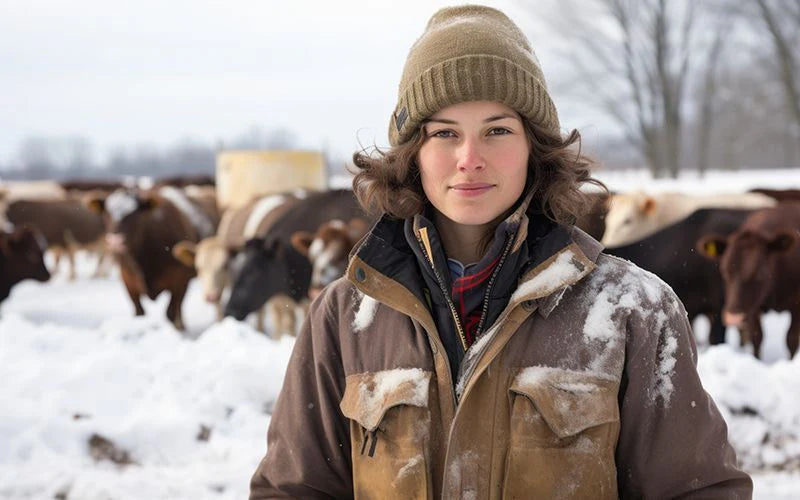
Cold Weather Clothing Guide: What to Wear When It's 20 Below
|
|
Time to read 4 min
 You are being redirected to QC Supply Pharmacy, where you’ll find a wide selection of high-quality prescription and pharmaceutical products for animals of all sizes.
Enjoy the same great service and expertise you trust from QC Supply.
Click below to continue shopping.
Continue
No thanks, stay on the main site
Powered by
You are being redirected to QC Supply Pharmacy, where you’ll find a wide selection of high-quality prescription and pharmaceutical products for animals of all sizes.
Enjoy the same great service and expertise you trust from QC Supply.
Click below to continue shopping.
Continue
No thanks, stay on the main site
Powered by


|
|
Time to read 4 min
Even when the wind is howling and outdoor temperatures dip below zero, many of us, from construction workers, homesteaders, and farmers have no choice but to go outside and tend to their chores. The challenge is figuring out how to dress warmly enough to remain comfortable for the possibility of spending hours on end outdoors, while still being sufficiently mobile and dextrous to get all the work done. And you have to prepare for working in a variety of temperatures, given that your work will take you inside and out. Though you don't have to spend hours out in the fields tending to the crops in winter, you still must feed and care for your animals in a variety of "microclimates."
Winter is also the perfect time for performing long overdue maintenance on your farm equipment to get it ready for the spring planting season.
Following conventional wisdom, dressing in layers is the best approach, not only for staying warm outside but for easily adjusting to moving between indoors and out. Your outerwear, whether it's a coat or jacket, should be insulated to protect from the wind and rain. At the same time, however, it mustn't be so bulky that it restricts movement in your arms. In addition to offering protection from the elements, one of the most important features of a winter jacket is an abundance of pockets where you can keep needed hand tools and assorted gear such as a phone, flashlight, or other tools.
A couple of great choices come from our own Five Rock. Including the Five Rock Deluxe Insulated Chore Coat pictured below and the Five Rock Quilt-Lined Hooded Jacket. Both options check off all the boxes; plenty of pockets, nice and warm, and definitely not bulky.
For those frigid, windy days when you have to spend much of your time outdoors clearing snow or storm debris, we recommend our Five Rock Heavy-Duty Deluxe Insulated Coveralls, a tried and true winter wardrobe staple for northern farmers and outdoor workers everywhere (pictured below). Not looking for full coveralls, but still looking for full-body coverage? Try our Five Rock Deluxe Insulated Bib Overalls.
You may have heard the old myth that you lose around half your body heat through your uncovered head in winter. While recent scientific studies debunk the magnitude of the heat loss, it is a valid consideration. Any uncovered body parts will result in heat loss. The extent of the heat loss is proportional to the body's surface area. So even though the human head only accounts for 7% of the total, when temperatures take a nosedive, it's important to wear a warm hat, and a great choice is the Five Rock Stocking Cap.
Experienced farmers will tell you the key to working effectively outdoors in winter is keeping your hands and feet warm, which is a challenge in sub-freezing temperatures, particularly when it's windy. In the extreme cold, your body has to work overtime keeping you warm, giving priority to your internal organs, thus leaving your extremities vulnerable. Frostbite is an ever-present danger for fingers and toes, as well as earlobes and nose, but you can avoid it when you wear proper clothing, including waterproof, insulated footwear, gloves, and headwear with ear and face protection.
The following National Weather Service Windchill Chart provides guidelines regarding the weather conditions and exposure that can lead to frostbite:
In addition to the clothing tips we've outlined above, the following are some additional measures you can take to maximize your comfort and safety working outdoors in the extreme cold:
For homesteaders in the northern half of the country who have chosen to work the land and raise their livestock, winter is a challenging season, particularly during the dreaded, inevitable "polar vortex." But by choosing the proper clothing, and paying particular attention to your feet and hands, you don't have to let it slow you down.
Do you have your own tips for working outdoors in brutal winter temperatures and/or conditions? Leave a comment below!
At QC Supply, we offer a wide range of winter clothing and accessories to keep you warm during the coldest months. Explore our selection of thermal underwear , insulated jackets , and winter accessories to find the perfect gear for your needs. For personalized assistance, feel free to contact us at 888.433.5275 or visit our website .